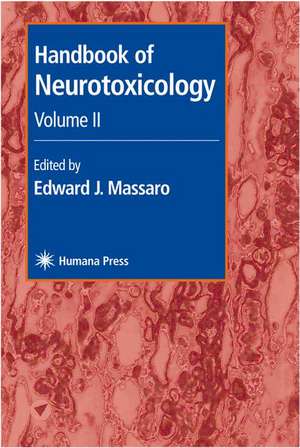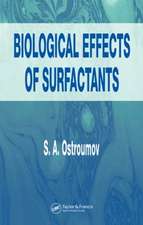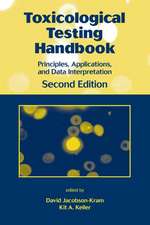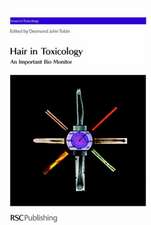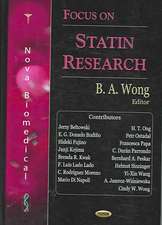Handbook of Neurotoxicology: Volume II
Editat de Edward J. Massaroen Limba Engleză Hardback – 20 mar 2002
| Toate formatele și edițiile | Preț | Express |
|---|---|---|
| Paperback (2) | 1344.04 lei 38-45 zile | |
| Humana Press Inc. – 16 dec 2010 | 1344.04 lei 38-45 zile | |
| Humana Press Inc. – 5 noi 2010 | 1477.49 lei 38-45 zile | |
| Hardback (2) | 1413.74 lei 6-8 săpt. | |
| Humana Press Inc. – 20 mar 2002 | 1413.74 lei 6-8 săpt. | |
| Humana Press Inc. – 12 noi 2001 | 1603.76 lei 6-8 săpt. |
Preț: 1413.74 lei
Preț vechi: 1488.14 lei
-5% Nou
Puncte Express: 2121
Preț estimativ în valută:
270.69€ • 281.87$ • 224.59£
270.69€ • 281.87$ • 224.59£
Carte tipărită la comandă
Livrare economică 14-28 februarie
Preluare comenzi: 021 569.72.76
Specificații
ISBN-13: 9780896037960
ISBN-10: 0896037967
Pagini: 594
Ilustrații: XVI, 594 p. 32 illus., 11 illus. in color.
Dimensiuni: 178 x 254 x 29 mm
Greutate: 1.12 kg
Ediția:2002
Editura: Humana Press Inc.
Colecția Humana
Locul publicării:Totowa, NJ, United States
ISBN-10: 0896037967
Pagini: 594
Ilustrații: XVI, 594 p. 32 illus., 11 illus. in color.
Dimensiuni: 178 x 254 x 29 mm
Greutate: 1.12 kg
Ediția:2002
Editura: Humana Press Inc.
Colecția Humana
Locul publicării:Totowa, NJ, United States
Public țintă
ResearchCuprins
1 Developmental Neurotoxicology: Testing and Interpretation.- 2 Manifestations of CNS Insult During Development.- 3 Developmental Neurotoxicity: What Have We Learnedfrom Guideline Studies?.- 4 Risk Assessment of Developmental Neurotoxicants.- 5 Electrophysiologic Evidence of Neural Injury or Adaptation in Cocaine Dependence.- 6 Addictive Basis of Marijuana and Cannabinoids.- 7 Dopamine and Its Modulation of Drug-Induced Neuronal Damage.- 8 NMDA Antagonist-Induced Neurotoxicity and Psychosis: The Dissociative Stimulation Hypothesis.- 9 Emerging Drugs of Abuse: Use Patterns and Clinical Toxicity.- 10 Mechanisms of Methamphetamine-Induced Neurotoxicity.- 11 Neurotoxic Effects of Substituted Amphetamines in Rats and Mice: Challenges to the Current Dogma.- 12 Studies of Neural Degeneration Indicate that Fasciculus Retroflexus Is a Weak Link in Brain for Many Drugs of Abuse.- 13 Microsensors Detect Neuroadaptation by Cocaine: Serotonin Released in Motor Basal Ganglia Is Not Rhythmicwith Movement.- 14 Impact of Intoxication: Structural and Functional Modificationsin the Brain Induced by Ethanol Exposure.- 15 Structural and Functional Neuroimaging of the Effects of Opioids.- 16 Structural and Functional Neuroimaging of the Effects of Cocaine in Human and Nonhuman Primates.- 17 Functional Neuroimaging of Cannabinoid Effects.- 18 Neuroimaging of MDMA-Induced Neurotoxicity.- 19 Tier 1 Neurological Assessment in Regulated Animal Safety Studies.- 20 Neurological Assessment: The Role of the Clinicianin Clinical Neurotoxicology.- 21 Human Neuropsychological Testing and Evaluation.
Recenzii
"This book presents a set of 21 well-chosen, up to date, reviews of a range of important topics of direct interest to neurotoxicologists in particular, but also to anyone with an interest in animal models of nervous system disease or in pathogenesis. As the title of this proposed series of volumes implies, the editors intend to cover the whole of the field, by adding further volumes in response to reader's requests - so no excuses for gaps!...The coverage is wide...It would be a pity if the emphasis on drugs of abuse put non-specialists off buying the book, because the strong mechanistic treatment of many of the chapters emphasizes the useful parallels with other, less "stimulating", neurotoxic agents. This is certainly not a book just about overdose pharmacology. " - Newsletter of the British Toxicological Society
"The Handbook of Neurotoxicology is an essential addition to the library of any serious researcher in any field of neurotoxicology and should be available in all university libraries where chemistry, biochemistry, or medical or life sciences are studied." - Journal of Natural Products
"Both volumes are laid out attractively...and contain much valuable information on the pharmacological aspects of neurotoxicology, as well as state-of-the-art methodology." Le Journal Canadien Des Sciences Neurologies
"The Handbook of Neurotoxicology is an essential addition to the library of any serious researcher in any field of neurotoxicology and should be available in all university libraries where chemistry, biochemistry, or medical or life sciences are studied." - Journal of Natural Products
"Both volumes are laid out attractively...and contain much valuable information on the pharmacological aspects of neurotoxicology, as well as state-of-the-art methodology." Le Journal Canadien Des Sciences Neurologies
Textul de pe ultima copertă
Neurotoxins-whether natural products that can provide valuable therapeutic agents and research reagents or human-generated pollutants-have recently attracted great scientific interest. In the Handbook of Neurotoxicology, Volumes I and II, many leading researchers and clinicians-all acknowledged experts-review in depth the status of research in key areas of current neurotoxicologic interest and examine the latest methodologies for in vivo assessment of a wide spectrum of agents exhibiting neurotoxicologic properties. This second volume of the Handbook focuses on the biologic effects of human-made toxins on the developing organism, and of drugs of abuse. Here are discussed the interpretation of neurotoxicity data, the art of risk assessment, and the manifestation of CNS insult during development. The drugs of abuse surveyed include cocaine, marijuana, the cannabinoids, and amphetamines. Also provided are state-of-the-art methods for the evaluation of neurotoxicant effects by both imaging and neurobehavioral assessment. Volume I concentrates on the biological effects of both human-made neurotoxins (pesticides, mercury, lead, zinc, and polytypic by-products of combustion and manufacture) and those of natural origin (microbial and animal toxins).
Up-to-date and timely, the Handbook of Neurotoxicology, Volumes I and II, not only affords today's biomedical and clinical investigators a full panoply of knowledge in all the critical areas of current neurotoxicologic interest, but also illuminates the latest methodologies for assessing the effects of a broad spectrum of significant neurotoxicological agents.
Up-to-date and timely, the Handbook of Neurotoxicology, Volumes I and II, not only affords today's biomedical and clinical investigators a full panoply of knowledge in all the critical areas of current neurotoxicologic interest, but also illuminates the latest methodologies for assessing the effects of a broad spectrum of significant neurotoxicological agents.
Caracteristici
Includes supplementary material: sn.pub/extras
